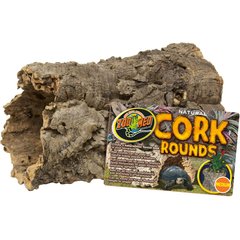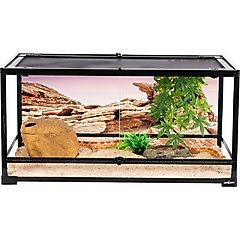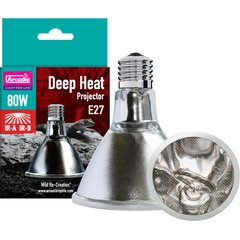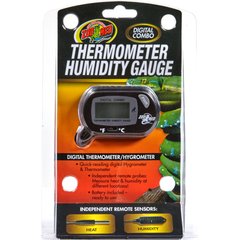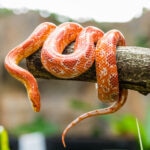Why Your Ball Python Won’t Eat and What to Do
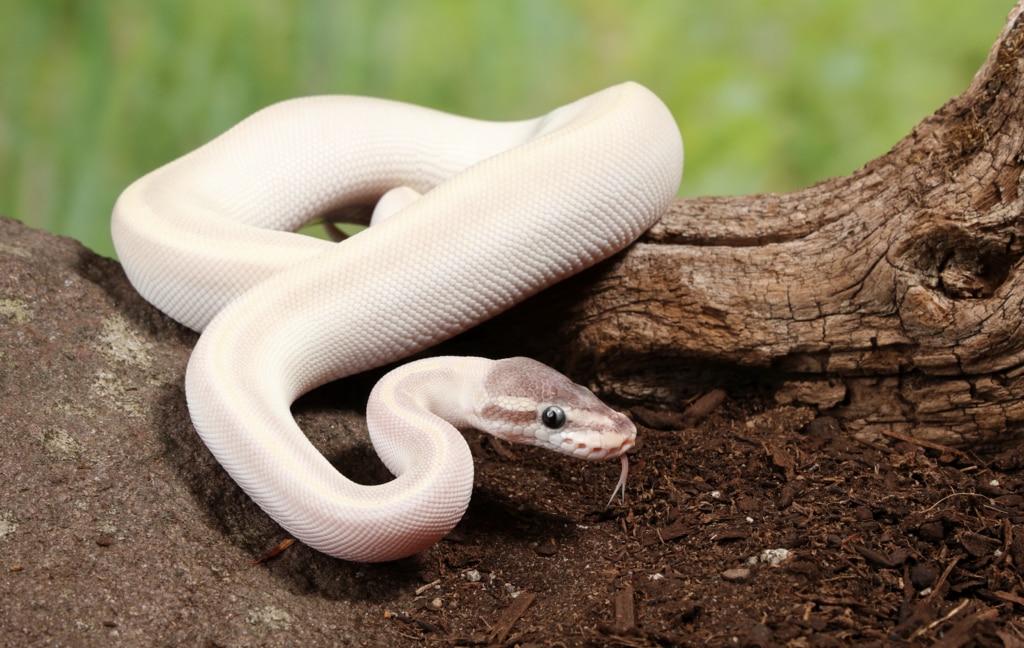
Photo by David Kenny/iStock/Getty Images Plus
Ball pythons have a reputation for going on hunger strikes. While it’s true that they can be picky eaters, there’s usually more to the story. Let’s dig into the most common reasons they decide to skip dinner and what you can do about it.
Key Takeaways
- If your snake stops eating, double-check that everything in their habitat is properly functioning.
- Your snake may want warmer food or a different type of food.
- Contact a veterinarian if you can’t pinpoint the cause of your pet’s refusal to eat.
Common Reasons Your Ball Python Won’t Eat
Even the most mild-mannered, food-loving ball python may still go off feed for any of the following reasons:
Environmental Factors
Although ball pythons are very tolerant of small variations and not-quite-perfect conditions, things can still crop up that cause stress and put them off their food.
Most of the time, the problem is in their needs not being met, explains Rob Coke, DVM, Dipl. ABVP (Reptile & Amphibian), ACZM, CVA and medical director of South Texas Avian and Exotic Hospital. Dr. Coke says that when a ball python has gone off feed, “We really try to concentrate on [overall care] because there’s always something that’s typically different or off or changed.”
Dave McGowen of Texoma Reptiles agrees and says that when your ball python stops eating, you should first make sure you’re meeting their environmental needs.
When you wonder why your ball python isn’t eating, there are a few things you can look for:
- Lack of clutter and hides can stress out a ball python. Sometimes, a pet ball python stops eating right after they come home because they were previously kept in a small container and then transferred to a big enclosure without enough places to hide.
Recommended Products
- Check temperatures in the hot and cool sides of your terrarium. Snakes, like all other reptiles, control their body temperature by moving back and forth between warm and cool zones.
- The humidity in the tank should also be checked. Most people have trouble keeping enough humidity in their ball python’s enclosure, but too much humidity can cause its own problems.
Seasonal or Natural Behavior
Some seasonal patterns can affect your ball python’s appetite. They’re more likely to fast during the winter months, especially if the room where their enclosure is located gets chillier.
Even with heating and a thermostat, some homes get colder at night, which can make your scaly friend decide that fasting is a better option.
Recommended Products
The spring breeding months tend to make males much more active, looking for a female and less interested in food. Females, on the other hand, do not eat if they’re gravid (pregnant) or incubating eggs.
Feeding-Related Issues
Ball pythons may have an issue directly with their food. Consider the following food-related possibilities:
- Feeder animal is too big: Even though a snake’s skull and jaw are extremely flexible, they can’t actually dislocate their jaw. A prey animal bigger than about 1.25 times the size of the widest part of their body is simply too big.
- Switching from live food to frozen/thawed: Reptiles should always be fed frozen/thawed food if possible. When making the switch from live to frozen food, you may waste a few feeders before your ball python starts eating again.
- Feeding when your snake isn’t active: Timing is everything; Dr. Coke explains that by paying attention and feeding your snake when they are naturally active, they may be more interested in food.
- Food temperature is critical: Ball pythons use all their senses to find prey, including heat-sensing pits along their lips. Frozen/thawed food should be warm enough to trigger a feed response (around 100 F).
Health Concerns
While sickness is rare when your ball python is in a healthy enclosure setup, they can become ill on occasion. They can have trouble with parasites or various infections affecting their respiratory system, scales, or mouth, among other ailments. All these things can make a snake lose their appetite.
If your ball python refuses to eat, make sure they’re otherwise healthy. Look for shedding problems such as stuck shed, mites, or signs of infection in their scales or around their mouth.
Even if your ball python looks OK but something seems “off,” set up an appointment with your veterinarian.
How Long Can a Ball Python Go Without Eating?
A healthy adult ball python can go several months without eating—as long as they aren’t losing weight. Dr. Coke explains that adult male ball pythons over 2–3 years old may only eat a few times per year.
McGowen agrees, explaining that as long as their body condition looks good and their enclosure is set up correctly, there’s probably nothing to worry about—the snake may not be hungry.
However, the same is not true with baby snakes. McGowen explains, “If a baby snake is not eating, that’s more of a crisis because they can crash and burn.” Their bodies are still growing and need proper nutrition to develop accordingly.
The younger your ball python is, the more often they need to eat. Hatchlings up to 4–6 months of age need to eat weekly or more, making them much more sensitive, and a skipped meal could indicate or cause weight loss, shedding problems, or infections.
What To Do If Your Ball Python Won’t Eat
One skipped meal is not an emergency unless your snake has visible signs of distress or illness. So discard the rat they did not eat and try again in a few days—after you check and make necessary adjustments to the following:
Check The Conditions First
Confirm temperature and humidity in both ends of your snake’s enclosure—the cool side is often more humid than the warm. Make adjustments where necessary to temperature and humidity.
Make sure you have the correct number of hides. There should be at least three hides—one in each end of the enclosure and one in the middle.
Adjust Feeding Methods
First, make sure the feeder is warm enough, usually around 100 F. If it’s not, your snake may be too lethargic to eat.
But what happens when you know that their enclosure is perfect, the rat was warm enough, and your picky little ball python still turned up their snout. When your scaly friend decides it’s not dinner time, you have a few options:
- Switch up the prey animal—many keepers have two to three types of feeder animals in the freezer for this reason.
- Use feeding tongs to simulate movement—don’t just toss in a dead rat; make it interesting!
- Simulate a nest raid, with two to three small prey animals warmed up and tucked into a corner of the enclosure.
- Temporarily switch to live food until you get them eating again.
Consider Fasting as Normal (When Healthy)
Just like people, ball pythons are individuals—some are very active, while others are not. Their activity level and overall body condition are primary factors when you’re trying to figure out if their hunger strike is serious.
If your ball python is otherwise healthy, they may just not be hungry. Most adult ball pythons comfortably go weeks between meals and many keepers schedule feedings three to six weeks apart, depending on the size of their previous meal.
Breeding season can cause many adult male ball pythons to lose their appetite. According to Dr. Coke, if your house cools off in the winter and warms up a bit in the spring, that temperature change can trigger increases in the hormones that control breeding behavior.
Seek Veterinary Help
If your snake still won’t eat and they’re showing signs of illness, seek the help of your exotic veterinarian. Look for things like:
- Swelling around the face, head, or cloaca
- Stuck shed that doesn’t come off after a warm soak
- Mucus or bubbles around their snout
- Wheezy breathing sounds
- Lethargic—more than usual for a ball python
- Weight loss combined with any of these symptoms
Unfortunately, animals try to hide illness and injury because in the wild, those can be fatal. So reptile owners must be vigilant and monitor behavior and overall health as part of a daily routine.
Prevention Tips for the Future
Fortunately, keeping your ball python fed isn’t too hard. Ball pythons’ needs are simple:
- Keep enclosure conditions clean and consistent
- Develop a routine for feeding
- Keep their stress level low by handling properly
- Monitor their weight and behavior
- Vary the prey type, size, and feeding interval
- Make feeding time interesting
Remember that occasional fasting is usually not alarming, and you should always first troubleshoot the snake’s environment and prey if they aren’t eating.
